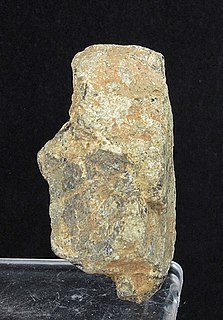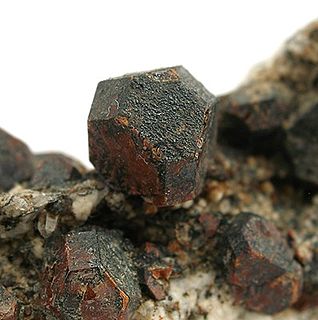
Euxenite, or euxenite-(Y), is a brownish black mineral with a metallic luster.

Samarskite is a radioactive rare earth mineral series which includes samarskite-(Y), with the chemical formula (YFe3+Fe2+U,Th,Ca)2(Nb,Ta)2O8 and samarskite-(Yb), with the chemical formula (YbFe3+)2(Nb,Ta)2O8. The formula for samarskite-(Y) is also given as (Y,Fe3+,U)(Nb,Ta)O4.

Allanite (also called orthite) is a sorosilicate group of minerals within the broader epidote group that contain a significant amount of rare-earth elements. The mineral occurs mainly in metamorphosed clay-rich sediments and felsic igneous rocks. It has the general formula A2M3Si3O12[OH], where the A sites can contain large cations such as Ca2+, Sr2+, and rare-earth elements, and the M sites admit Al3+, Fe3+, Mn3+, Fe2+, or Mg2+ among others. However, a large amount of additional elements, including Th, U, Be, Zr, P, Ba, Cr and others may be present in the mineral. The International Mineralogical Association lists four minerals in the allanite group, each recognized as a unique mineral: allanite-(Ce), allanite-(La), allanite-(Nd), and allanite-(Y), depending on the dominant rare earth present: cerium, lanthanum, neodymium or yttrium.

Aenigmatite, also known as Cossyrite after Cossyra, the ancient name of Pantelleria, is a sodium, iron, titanium inosilicate mineral. The chemical formula is Na2Fe2+5TiSi6O20 and its structure consists of single tetrahedral chains with a repeat unit of four and complex side branches. It forms brown to black triclinic lamellar crystals. It has Mohs hardness of 5.5 to 6 and specific gravity of 3.74 to 3.85. Aenigmatite forms a solid-solution series with wilkinsonite, Na2Fe2+4Fe3+2Si6O20.
Aeschynite-(Ce) is a rare earth mineral of cerium, calcium, iron, thorium, titanium, niobium, oxygen, and hydrogen with chemical formula (Ce,Ca,Fe,Th)(Ti,Nb)2(O,OH)6. Its name comes from the Greek word αισχύνη ("aeschyne") for "shame" because early chemists had difficulty with separations of titanium from zirconium.

Aeschynite-(Y) is a rare earth mineral of yttrium, calcium, iron, thorium, titanium, niobium, oxygen, and hydrogen with the chemical formula (Y,Ca,Fe,Th)(Ti,Nb)2(O,OH)6. Its name comes from the Greek word for "shame". Its Mohs scale rating is 5 to 6.

Polycrase or polycrase-(Y) is a black or brown metallic complex uranium yttrium oxide mineral with the chemical formula (Y,Ca,Ce,U,Th)(Ti,Nb,Ta)2O6. It is amorphous. It has a Mohs hardness of 5 to 6 and a specific gravity of 5. It is radioactive due to its uranium content. It occurs in granitic pegmatites.

Warwickite is an iron magnesium titanium borate mineral with the chemical formula (MgFe)3Ti(O, BO3)2orMg(Ti,Fe3+, Al)(BO3)O. It occurs as brown to black prismatic orthorhombic crystals which are vitreous and transparent. It has a Mohs hardness of 3 to 4 and a specific gravity of 3.36.

Cerite is a complex silicate mineral group containing cerium, formula (Ce,La,Ca)
9(Mg,Fe3+
)(SiO
4)
6(SiO
3OH)(OH)
3. The cerium and lanthanum content varies with the Ce rich species and the La rich species. Analysis of a sample from the Mountain Pass carbonatite gave 35.05% Ce
2O
3 and 30.04% La
2O
3.

Calderite is a mineral in the garnet group with the chemical formula (Mn2+, Ca)3(Fe3+, Al)2(SiO4)3.

Loparite-(Ce) is a granular, brittle oxide mineral of the perovskite class. It is black to dark grey and may appear grey to white in reflected light on polished thin section with reddish brown internal reflections. It has the chemical formula of (Ce,Na,Ca)(Ti,Nb)O3. Nioboloparite is a variation of Loparite-(Ce) containing niobium.

Cafarsite is a rare calcium iron arsenite mineral. Manganese and titanium occur with iron in the formula.

Tienshanite, named for the Tian Shan Range in Mongolia, is a rare borosilicate mineral, though rock-forming in some parts of its original locality at the Dara-i-Pioz Glacier in Tajikistan. Its formula is extremely complex: KNa3(Na,K,[])6(Ca,Y,RE)2Ba6(Mn2+,Fe2+,Zn,Ti)6(Ti,Nb)6Si36B12O114[O5.5(OH,F)3.5]F2.
Cleusonite is a member of the crichtonite group of minerals with the chemical formula (Pb,Sr)(U4+
,U6+
)(Fe2+
,Zn)
2(Ti,Fe2+
,Fe3+
)
18(O,OH)
38. This group of minerals contains approximately thirteen complex metal titanates. The structures of minerals of this group is complicated by frequent fine-scale twinning and metamictization due to radioactive elements. The crichtonite group consists of members of related mineral species of the type A{BC2D6E12}O38 which are characterized by their predominant cations (as seen in crichtonite (Sr), senaite (Pb), davidite (REE + U), landauite (Na), loveringite (Ca), lindsleyite (Ba), and mathiasite (K).

Lulzacite is a strontium-containing phosphate mineral with the chemical formula Sr2Fe2+(Fe2+,Mg)2Al4(PO4)4(OH)10.

Walfordite is a very rare tellurite mineral that was discovered in Chile in 1999. The mineral is described as orange with orange-yellow streak, and is determined to have a chemical formula of Fe3+,Te6+Te4+3O8 with minor titanium and magnesium substitution resulting in an approximate empirical formula of (Fe3+,Te6+,Ti4+,Mg)(Te4+)3O8.
Loveringite is a rare metallic oxide mineral of the crichtonite group with the chemical formula (Ca,Ce)(Ti,Fe,Cr,Mg)21O38. It is a late-stage magmatic mineral, formed in the residual melt of mafic layered intrusions in either the olivine-chromite, pyroxene, or plagioclase-rich layers.
Mawsonite is a brownish orange sulfosalt mineral, containing copper, iron, tin, and sulfur: Cu6Fe2SnS8.
Dessauite-(Y) is a mineral member of the crichtonite group with the formula (Sr,Pb)(Y,U)(Ti,Fe3+
)
20O
38. It is associated with derbylite, hematite, rutile, karelianite, siderite, and calcite. Founded in the Buca della Vena Mine, Tuscany, Italy, the mineral was called dessauite in honor of professor Gabor Dessau (1907–1983).














